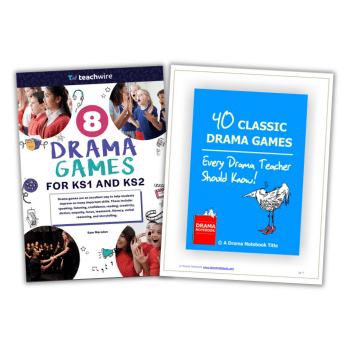Drama games – Simple ideas for primary school

Need to inspire your pupils and encourage creativity? Try these easy-to-follow and fun exercises, says Samantha Marsden…

These drama games from Samantha Marsden are simple to explain, don’t need any resources and are perfect for primary-aged children...
Drama games for primary students
1 | Yes, Let’s!
Initiate an action by saying something like, “Let’s bake a cake.” Pupils reply with, “Yes, let’s!” and then pretend to bake a cake.
Invite students to shout out ideas too. For example, someone might shout, “Let’s wash a lion!”. Again, everyone replies “Yes, let’s!” and mimes washing a lion.
Continue the game like this, with no idea being too silly.
2 | Lie about how you got here
Ask students to sit in a circle. One by one, each student lies about how they got to class.
This could be by flying car, unicorn, or time travel. Anything goes in this exercise. Encourage students to really tell a story and give details.
3 | Soundscape drama games
Ask students to sit in a circle. Explain that they’re going to create the atmosphere of a place with sounds. Try these ideas:
- seaside
- school
- big city
- jungle
- zoo
- fairyland
Ask someone to start. They must repeat their chosen noise or phrase over and over again.
Then the person next to that student adds their noise, and so on.
4 | Acting to music
Ask everyone to lie down and play a piece of music. After about 30 seconds, tell students that when they’re ready, they can stand up and move around the room in response to how the music is making them feel.
The music may inspire them to, for example:
- be a wizard, skipping to wizard school
- walk through a cave, terrified
- sit quietly and reflect on happy times
Tell children to follow their intuition and not to pay attention to anyone else in the group. It’s about whatever the music inspires in them.
5 | I’m sorry I…
One person – let’s call her Rania – stands up and approaches a person sitting in a circle – let’s say Maya – and she apologises for something.
Rania might be very sorry because she has lost Maya’s pet dog, or she’s cast an irreversible spell on her brother. Maya reacts how she likes.
Maya can then pick someone else in the circle and approach them to apologise for something.
6 | Broken down lift
Mark out a square or rectangle that is about the size of the floor space in a lift. Ask four actors to think up an objective for the character they will play.
They get into the lift in character, and the improvisation begins. Explain that at some point in the improvisation, they need to imagine that the lift breaks down.
7 | Magic box drama games
Sit in a circle with your students and mime placing an imaginary box in front of yourself. Explain it’s a magic box and inside there are many different kinds of objects.
Open the lid and mime taking something out of the box. Put the thing back into the box and ask the audience to guess what it was.
Pass the magic box to the next person to mime with.
8 | Lead with your…
Direct students to walk around the room. Now explain that you will call out a body part that students are to lead with.
Let’s start with the nose, for example. Ask the students to think about what type of character might lead with their nose.
Lead with many different body parts. Then ask the class to sit down and see if any volunteers would like to show some of the characters they’ve created.
—
9 | Fruitbowl
Fruitbowl is excellent for teaching interpersonal skills, including concentration, listening, teamwork, self-control and spatial awareness.
Sit in a circle on chairs. Give everyone the name of a fruit in turn, e.g. apple, pear, banana, apple, pear, banana.
One player stands in the middle of the circle and their chair is taken away. The player in the middle calls out one of the fruit names. All players with that fruit name must leave their seat and run to another chair.
While the ‘fruits’ are changing places, the player in the middle also tries to find a seat. When everyone has swapped seats, one player will be left in the middle again.
This player calls out a fruit name, and the process is repeated. If the player in the middle calls out ‘FRUITBOWL!’ every player must change places and move to a new seat.
10 | Grandmother’s Footsteps
Simple movement activities, such as freezes and mime, will develop creative concentration skills. Grandmother’s Footsteps is great for working on controlled movement.
A player stands at the end of the room with their back to the rest of the group. Place a beanbag or small object between their feet.
Everyone tries to creep up to steal the beanbag. The player turns around at regular intervals and, when they turn, everyone freezes. Anyone moving when the player turns around goes back to the beginning.
The winner is the person who steals the beanbag. They become the new ‘It’ and the game begins again.
For less confident children, follow-my-leader and copying activities – with the teacher at the front of the class – are good for building confidence in a non-threatening way.
You can also adapt party games, such as musical statues, by asking pupils to freeze as characters from a book, film or story.
11 | Objects
This activity encourages children to respond creatively – and quickly. Divide into groups of four to six players. Call out the name of an object and the groups have ten seconds to make the shape of that object using their own bodies, joining together in different ways.
Count down slowly from ten to zero then shout ‘Freeze!’ Try: car, clock, television, bed, or volcano.
12 | Explore stories
Traditional stories and rhymes work really well when used as a stimulus for drama in the classroom. In Year 1 children will happily act out stories and poems as a whole group and will fully engage with, for example, creating whole-group mimes of different scenes.
13 | Teacher in role
To encourage creativity, teacher-in-role is a great technique. Pretend to be, for example, Goldilocks, and allow yourself to be interviewed about your behaviour.
Become Cinderella and ask the children what you need to fetch to create the golden carriage. Add a prop or costume item and become a bullied child looking for advice, a Roman soldier, an Aztec, a Victorian child – the list is endless!
14 | Create whole-class drama
Read the beginning of a story, for example The Giant Turnip, and ask children what they would like to explore, then allocate roles and work to develop their ideas. Use freezes, mime, improvisation and teacher-in-role to explore character and story.
Thank you to Alison Chapman for ideas 9-14. Alison runs Arts on the Move, providing drama teaching resources and information.
Drama games for SEND pupils

Use these drama games to encourage your children with SEND to expand and explore what makes them unique, rather than shrinking to fit a non-existent ‘norm’…
Drama games for acceptance
Too often, SEND pupils are required to shrink themselves to fit in. But drama is a place that allows them to expand and express themselves.
Things I will often be found saying in the drama class are: “There is no wrong way”, “Don’t worry about what others think”, and “Do the first thing that comes into your head”.
However, not all drama activities are helpful. There are some harmful drama games out there that can panic children and make them feel rejected.
“Drama is a place that allows them to expand and express themselves”
When choosing content, I recommend making sure you choose drama games and activities that bring the class together. Avoid drama games that have winners and losers.
Drama games for focus
I’ve seen children who usually struggle with focus pay attention well in the drama classroom. Pupils with ADHD can find drama practically engaging.
A well-planned drama lesson should be fast-paced, and engage students physically, vocally, creatively, and mentally. When performing a live improvisation in front of the class, there is no room for your attention to drift!
There are many drama activities to help students slow down and focus, too, such as relaxation exercises to music, Stanislavski’s circles of attention, Lee Strasberg’s imaginary object exercise, and counting to 20 as a group.
For counting to 20 as a group, each number is said by one person at random. If two people say the number at the same time, the group go back to number one. It’s a great activity to calm the energy and bring the class back to focusing on a common goal.
Drama games for inclusivity
When taught well, drama is a subject that offers a safe space to express creativity, to work in teams, all while increasing confidence. But when taught badly, it can further exclude.
‘Yes, lets’ is one of my favourite warm-up drama games, as everyone’s ideas are welcomed and executed. This involves proposing an idea to be mimed, and a positive response (think improv basics). For example, you might say, “Let’s all read a book” and everyone shouts, “Yes, lets” – at which point you all mime reading a book.
Trending
You might continue, “Let’s all ride a unicorn”. Pupils reply “Yes, lets”, and you all mime riding a unicorn. After you give a few examples, and when the game is in full swing, ask students to put their hands up if they have an idea.
Explain that all ideas, except for violent ones, are welcome. Try and give as many pupils as possible a go, and encourage (but don’t force), reluctant children to offer an idea.
Dyslexia and drama games
Drama can be very empowering for students with dyslexia. I have dyslexia and for a long time, drama was the only subject I was good at.
It was a place where I didn’t have to worry about words, numbers, or remembering information. I could use my imagination, and verbal reasoning skills, which were my strengths. It was one of the few practical subjects where I could get up on my feet and do.
“Drama can be very empowering for students with dyslexia”
I’m not alone as I’ve taught dozens of students with dyslexia since, who also love drama as it’s a subject where they get to use their strengths and forget about their weaknesses.
Try different explanations
People receive information in different ways, and for inclusivity, I believe it’s important for the teacher to communicate using several methods. I often explain an activity in two different ways, or sometimes three, always using words, tone of voice, movement, and facial expressions to communicate. Because for some children, visual signals can really help them.
For example, if I have a SEND student in the class who responds well to pictures, I will make sure to include visuals in my explanations for the whole class. If I ask the class to imagine it’s snowing, for instance, I will pretend to be very cold, and may even hold up a picture of snow.
I am likely also to play a piece of music that sounds snowy too, so that pupils have audio and visual guides to improvise with as they go on their snowy adventure.
How to deal with overwhelm
If a pupil becomes overwhelmed, try and keep the class energy calm. Some focus drama games, breathing exercises, or mindfulness activities might help to bring down the energy of the group.
Offer the overwhelmed student a quiet place to sit, and explain that they may watch and join in when they are ready.
If the class is independently rehearsing short scenes or improvisations, some SEND students might benefit from rehearsing in a quiet space, away from the rest of the class. This can prevent other children practising becoming a distraction, or being too overwhelming for them.
- Outline the content of the class at the start of the lesson to help SEND pupils who respond well to structure. Many children with SEND find it comforting to know what to expect. If possible, write this on a board to help anchor these pupils.
- No idea is too silly in drama. Encourage and praise pupils when they share their creativity.
- One way to start the class is to get children into a circle and then ask them to do a vocal warm-up. For example, ask them to moo, meow, or woof to the tune of ‘Twinkle, Twinkle Little Star’. Or you can do some tongue twisters, or funny sounds, all together.
- Follow this up with a quick movement warm-up. For example, ask the class to imagine chewing on a big toffee, or biting into a rotten apple, or that they are a tiny seed growing into a beautiful flower, slowly.
- For inclusivity, never tolerate any unkind comments, looks, gestures, or laughs. If this happens, take the offending pupil aside and explain kindness and acceptance are essential in drama. If this doesn’t improve the behaviour, you may need to remove them from the group temporarily.
How to teach literature through drama games

From pretending to eat chocolate cake to navigating Narnia in their imaginations, exploring literature as performers will fuel pupils’ creativity and inspire deeper textual understanding…
Bringing drama games and acting techniques into your classroom makes the study of literature more active. It will inspire pupils to engage with literature in a practical, character-driven way.
Thinking about the study of literature can conjure images of quiet libraries filled with students poring over books. However, reading and writing both involve the study of people, relationships, and what it means to be human, though – just like acting.
So it’s no coincidence that there are many actor-writers. Examples include Phoebe Waller-Bridge, Tina Fey, Spike Lee and, of course, Shakespeare.
Larraine S Harrison, author of Drama and Reading for Meaning Ages 4-11 (Routledge 2022), explains how using drama games in the classroom can work:
“Stepping into an imaginary context encourages children to view texts through the lens of different perspectives,” she says. “It fosters an emotional engagement that can motivate and inspire children to peel back the layers of a text and dig a little deeper.”
Acting techniques can build a bridge between text and imagination, maybe even inspiring a love of reading for life. Here are some ideas to help you apply this approach in your classroom…
Acting activities for literature
Yes, Let’s
‘Yes, Let’s’ is a simple, well-known drama game that can also be adapted to help students connect with a text.
To play, explain that everyone acts out what the idea-caller (you, the teacher) calls out. For example, if you are studying Matilda, you might say, “Let’s all be Bruce and eat a chocolate cake.”
“Acting techniques can build a bridge between text and imagination”
The class should then reply “Yes, let’s!”, after which everyone pretends to eat chocolate cake.
Give it about a minute before you call out the next idea.
Next you might say, “Let’s all copy sums from the board, Ms Trunchbull is watching!” and the class would reply, “Yes, let’s!” before pretending to do this.
After you’ve shared a few ideas, ask pupils to share their own ideas for things that everyone can do.
Yes, Let’s can work with any text. For example, if you’re studying The Lion, The Witch and The Wardrobe, students are likely to love it if you say, “Let’s all walk through the wardrobe into Narnia!”
To extend this, you could read out a description of Narnia from the text while students walk around and imagine the world you’ve described.
Character studies
One way to study literature is to help students get inside the characters’ minds and worlds.
Konstantin Stanislavski, one of the most influential acting teachers in the world, coined the term ‘given circumstances’. This refers to the environmental, historical, and situational conditions in which a character finds themselves.
When studying a book or script, ask pupils to choose one of the characters, and a particular point in the book. They can then write out the character’s circumstances at that time.
For Stanislavski, six questions make up a character’s given circumstances:
- Who?
- When?
- Where?
- Why?
- For what reason?
- How?
You can reassure the children that for some of the answers, different people will have different interpretations, and that’s great.
Here is an example of a character sheet template that I like to use with pupils:
- Name:
- Age:
- Where do you live?
- What’s your bedroom like if you have one?
- Have you had any life-changing events? If yes, what happened and how did it change you?
- Who do you have significant relationships with?
- Who’s your favourite person?
- Who’s your least favourite person?
- If you had three wishes, what would you wish for?
- What do you most want from life?
- What scares you the most?
- What’s your life philosophy in a nutshell?
- What makes you angry?
- What’s your biggest secret?
Begin by asking the children to choose a character from the text that’s being studied. Then ask them to answer the questionnaire in first-person.
Encourage them to draw the answers from the text when possible, and to fill in blanks with their imaginations.
Objectives
Actors and directors spend a lot of time thinking and talking about objectives (the character’s wants).
You can ask pupils to write down, discuss, or improvise the character’s objectives. This can be done on a per sentence, per scene, or whole-story basis. According to Stanislavski there are two types of objectives: the objective and the super objective.
The objective is the want in the scene, or sentence. The super objective is the character’s main want – their life ambition perhaps – or the overarching desire that drives the story.
Of course, opinions may vary on what a character’s objective and super objective are. That’s all part of the fun when investigating a text together! Ask your class to share parts of the text that support their argument.
You can also split students into pairs and ask them to create an improvisation from objectives. For example, if you’re studying Alice in Wonderland, you could ask them to create an improvisation with Alice and the White Rabbit.
Explain that Alice’s objective is to get home. Meanwhile, the White Rabbit is running late, and their objective is to arrive for a job for the Duchess.
Give the pairs five minutes to come up with an improvisation. Then ask them to share with the rest of the class if they feel comfortable doing so.
Hot seating
To help students get into the minds of the characters you’re studying, you can try hot seating.
Place a chair in front of the class, and then ask for a volunteer to sit on it. Task them with thinking of a character from the book, or script, you’re working on.
Ask them to try and think of all the character’s given circumstances. Their answers should include their age, name, job, place that they live, friends, family, likes, dislikes, fears, wants, and so on.
Explain to the child that they can make up any information that hasn’t been given in the text. Now, in character, the improviser answers questions from the audience in character. If they don’t know the answer to a question, they can make up an answer, or say, “I don’t know”.
The audience can ask any questions they like; see the character sheet template for ideas.
If you think some children might need a little more support, begin by providing some information about the characters. Write each character’s name on the board, then list their given circumstances, wants, fears, habits, relationships, and so on.
Make sure you explain that it’s okay for the same character to be played and hot-seated more than once; different interpretations are exciting!
These drama games come from the imagination of Samantha Marsden. She’s the author of 100 Acting Exercises for 8-18 Year Olds (£15.99, Methuen Drama). Follow her on Twitter at @SamMarsdenDrama. Download 48 more drama games for kids or a KS2 improvisation lesson plan. You can also read more advice for teaching drama for the first time.











